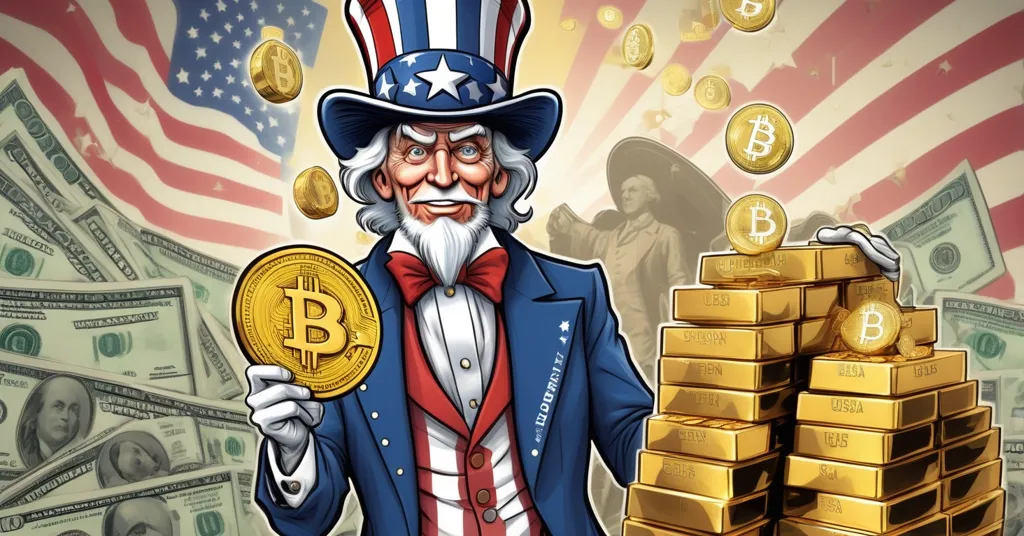Trump Unveils Plan for U.S. Bitcoin Dominance: National Stockpile and Stablecoin Support

Trump Declares Vision For America As The Undisputed Bitcoin Superpower
– Trump proposes a national Bitcoin stockpile.
– Aims to end regulatory war on crypto.
– Supports stablecoin legislation to boost USD dominance.
– Bitcoin recently dropped 22% from its all-time high.
At the Blockworks Digital Asset Summit in New York, former President Donald Trump unveiled a bold plan to position the United States as the global leader in cryptocurrency, with Bitcoin at its core. His vision includes creating a national stockpile of Bitcoin, ending the regulatory crackdown on crypto, and supporting legislation for stablecoins to enhance the dominance of the US dollar in the digital economy.
**Trump’s Vision**
Trump’s speech was a rallying cry for the U.S. to embrace cryptocurrency, particularly Bitcoin. He proposed the creation of a Strategic Bitcoin Reserve, a national stockpile intended to maximize the value of federal holdings. This move, if realized, could position the U.S. as a dominant player in the global crypto market. In essence, it’s like the government putting its money where its mouth is, betting big on Bitcoin.
“We’re ending the last administration’s regulatory war on crypto and Bitcoin,” Trump declared, signaling a significant shift in policy.
His vision includes fostering a supportive legal framework to encourage investment and innovation in the sector. “With the right legal framework, businesses of all sizes will be free to invest, innovate and take part in one of the most exciting technological revolutions in modern history,” he added, emphasizing the potential for growth and development in the crypto industry.
**Proposed Policies**
Trump also threw his weight behind stablecoin legislation, seeing it as a way to enhance the US dollar’s dominance in the digital economy. “I’ve also called on Congress to pass landmark legislation creating simple, common-sense rules for stablecoins and market structure,” he stated. He believes that with dollar-backed stablecoins, the U.S. can “unleash an explosion of economic growth, and… help expand the dominance of the US dollar.”
His comments come at a time when the U.S. Senate Banking Committee has advanced a bipartisan bill to regulate dollar-backed stablecoins, known as the GENIUS Act. This Act aims to establish a clear regulatory framework for digital assets, which has been lacking and has stifled innovation. In simple terms, the GENIUS Act is meant to clear the fog around stablecoins, making it easier for businesses to use them without fear of regulatory backlash.
**Market Impact**
However, the crypto market’s volatility presents a hurdle to these ambitions. Since its all-time high of $109,000 in January, Bitcoin has dropped 22%, trading at around $84,350. Market analysts suggest that the $80,000 level is a critical support floor, and failure to hold above $82,000 could lead to further declines. In the world of crypto, holding on tight is both a strategy and a rollercoaster ride.
**Challenges and Skepticism**
While Trump’s proposals are ambitious, the lack of detailed plans for the Strategic Bitcoin Reserve and the broader complexities of integrating cryptocurrencies into the financial system pose significant hurdles. Furthermore, the volatility of the crypto market, as evidenced by Bitcoin’s recent performance, adds another layer of uncertainty to these plans.
But let’s not let the crypto hype train derail our common sense. While Trump’s vision is exciting, it’s crucial to approach it with a healthy dose of skepticism. The crypto world is filled with promises of moonshots (huge price increases) and lambos (the dream of buying a Lamborghini with crypto gains), but the reality often involves more turbulence than a SpaceX launch. As we navigate this new frontier, it’s essential to keep our wits about us and not fall for every grandiose claim.
**Counterpoints and Perspectives**
While Trump’s vision aligns with the ethos of decentralization and economic freedom, it’s worth considering the potential pitfalls. Critics argue that a government-controlled Bitcoin reserve could undermine the very principles of decentralization that make Bitcoin valuable. Moreover, the focus on stablecoins might overshadow the importance of Bitcoin’s volatility and potential as a hedge against inflation.
Additionally, some political figures and economic experts have expressed concerns about the feasibility and implications of these policies. For instance, there’s a debate on how a Strategic Bitcoin Reserve would be managed and its impact on federal finances. The integration of cryptocurrencies into the traditional financial system is a complex task that requires careful planning and execution.
**Key Takeaways and Questions**
– **What is Donald Trump’s vision for the US in the cryptocurrency industry?**
Trump envisions the US as a dominant force in the cryptocurrency sector, particularly focusing on Bitcoin, through the creation of a national Bitcoin stockpile and fostering a supportive legal environment for crypto innovation.
– **How does Trump plan to support the cryptocurrency industry?**
Trump plans to end the regulatory war on crypto, establish a Strategic Bitcoin Reserve, and support stablecoin legislation to foster investment and innovation.
– **What is the current market situation for Bitcoin?**
Bitcoin has experienced a 22% drop from its all-time high of $109,000 to around $84,350, with the $80,000 level being a critical support floor.
– **What is the significance of the stablecoin legislation Trump supports?**
Trump believes that stablecoin legislation will enhance the dominance of the US dollar in the digital economy and facilitate economic growth through cheaper and faster transactions.
– **What challenges does Trump’s vision face?**
Challenges include market fluctuations, lack of detailed plans for the Strategic Bitcoin Reserve, and the broader complexities of integrating cryptocurrencies into the financial system.



